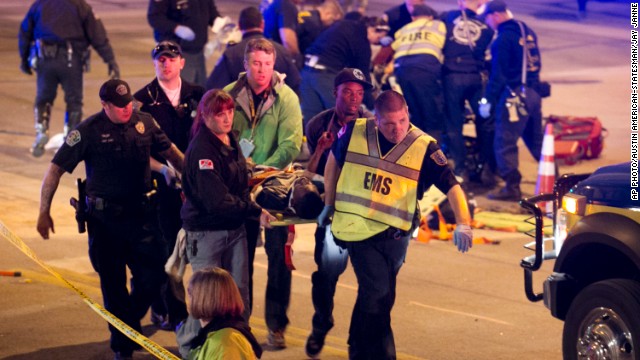
A lively night out at one of the year’s most popular festivals turned to carnage last night as a driver rammed through barricades into a pedestrian-only zone at the South By Southwest music-and-film festival in Austin.
In an attempt to avoid a drunk-driving check by a police officer, the driver -- allegedly driving a stolen car -- killed two people and injured 23 others. Two are in critical condition and three are in serious condition. The driver -- identified by the Austin American-Statesman as 21-year-old Rashad Charjuan Owens of Killeen, Texas -- tried to get away on foot after the car crashed.
It’s a grim reminder of how dangerous automobiles can be. People tend not to think of their cars -- mundane tools of everyday life -- as deadly weapons when they're driving. But motorists kill 92 people a day in the United States. Fifteen of them are struck while walking or riding a bicycle.
Owens faces two counts of capital murder and 23 counts of aggravated assault with a vehicle for the mayhem he caused last night. Unfortunately, it takes an event this over-the-top to get law enforcement to prosecute drivers who kill. Last fall, a cabbie who drove up onto a sidewalk in Midtown Manhattan, severing a tourist's leg, got off without even a citation. The driver -- a repeat offender -- only lost his taxi license for six weeks and now he's free to drive the streets again.
Of the two people killed last night in Austin, one was a Dutch man riding a bicycle. In his home country, drivers are far more likely to face consequences for injuries and deaths they cause with their cars.
The Netherlands applies a concept called “strict liability” to motorists who hurt pedestrians or cyclists. In their civil courts, the operator of the larger vehicle is presumed to be liable.
That would end the driver’s common defense of “she came out of nowhere!” attorney Bob Anderton of Washington Bike Law told an audience at the National Bike Summit last week:
When the bicyclist or pedestrian is on her way to hospital, or worse, who’s there to explain what happened? The driver. [And the driver says], ‘Well she came out of nowhere!’ It can’t be the fault of the driver; she just jumped right out; she must have been going too fast; she must not have been lights -- who knows? But it’s those crazy bicyclists.
In the Netherlands, Anderton said, drivers are liable for a crash unless they can prove it was caused by a force majeure -- an act of God. If a person on a bike or on foot is deemed to have half the blame, she still recovers 75 percent of her damages. And if the cyclist or pedestrian is 14 years old or younger, even if the driver can prove force majeure, it’s still the driver’s fault.
Denmark’s law isn’t quite as comprehensive, but drivers are found fully liable in 90 percent of crashes with bicyclists. Even Iceland, known for a car culture of long roads in wide open spaces, holds drivers responsible for damage caused by their motor vehicle, period.
These laws aren’t just punitive. “We need laws that motivate motor vehicle drivers to avoid these collisions in the first place,” Anderton said.
Strict liability isn’t as unthinkable as it may initially seem here, in a country that is so accustomed to giving drivers the benefit of the doubt.
“Can we really do it? It’s not crazy,” said Anderton. “There’s something called the following car doctrine -- which is not a statute but it’s common law -- and the basic rule is, if you’re driving behind somebody and you run into them, you’re presumed to be at fault.”
The same holds true with dogs. “The question isn’t, ‘were you negligent in controlling your dog?’” Anderton said. “The question is, ‘is this your dog?’ If your dog bit my kid, you’re responsible for it. That’s strict liability.”
Adults are often even held responsible for damage caused by their minor children, on the assumption that it’s the parents’ duty to keep their kids in line. Given that teenagers have minds of their own and cars don’t, it seems only reasonable to apply at least that level of liability to cars.





